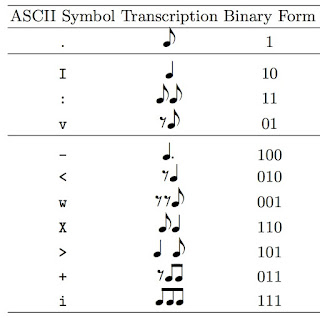Silence, Ties, and Subdivisions
Silences, aka rests, are a vital part of music (https://bit.ly/2lTTzm3). Therefore, today, I would like to show you how to notate rests with shorthand notation.Remember this table:
Some symbols already have rests, but what if you need longer silences?
The solution is very easy, simply use round brackets around a symbol or any sequence of symbols:
I(II) I(II) I:: X> HI I(H)
That's all fair and square, but what is this H doing here?
It has the value of four pulses, twice as much as I.
W symbolizes a whole note comprising eight pulses.
A word of caution: The shorthand notation is case sensitive. Uppercase symbols have a completely different meaning. Compare the uppercase I with the lowercase i in the table above.
The two other lowercase symbols in the table are w and v. Do not confuse w with W.
Also note that the fifth symbol is a dash - not an underscore _
You will realize that it easy to distinguish the symbols when you see them in context.
Here is another example of producing rests, this time with a sequence of 7 pulse patterns :
II- II> I(I-) I(I-) I:-
Now, you might wonder, what about tying notes together?
For this I use the wiggly symbol ~, also known as tilde.
This is very useful if you want to have really long note values:
W~W~W I (H~I)
To summarize: Use round brackets around symbols for silence. Use the tilde like this I~H for tying notes together. H and W are our new symbols for notes with 4, or 8 pulses in length.
Finally, what about those subdivisions? Here is the trick: Use square brackets [ ] around any sequence of symbols. This will divide their values in half.
I[::] I[::] H [>I>I>>] I(I)
If you want to read this :: as four eighth notes, then this [::] makes four sixteenth notes.
That was easy, what about triplets? Simply add a 3 after the opening bracket, like so [3III]
This says that the value for each symbol inside the bracket is divided by 3.
For example, Maurice Ravel's 'Bolero' opening would go:
I[3III] I[3III] II I[3III] I[3III] [3III III]
But, here is the catch: The shorthand notation has symbols for 3 pulses, so one could also write:
-i -i -- -i -i iiIf you need quintuplets, septuplets, etcetera, one should use square brackets [5.....], [7.......], and so on.
That's it! Once you're using this notation you will see how lightning fast you can write rhythms. Now, before we start composing, here is an exercise: Search up some Latin-American Salsa rhythms and write them down in shorthand. Sometimes they are called bell-patterns or timelines. We'll have a look at them next time. The shorthand notation is great for building a database of rhythmic patterns, and of course it's great for blogging as well...





No comments:
Post a Comment